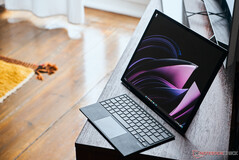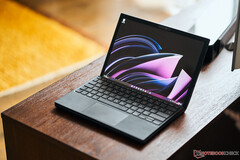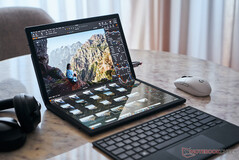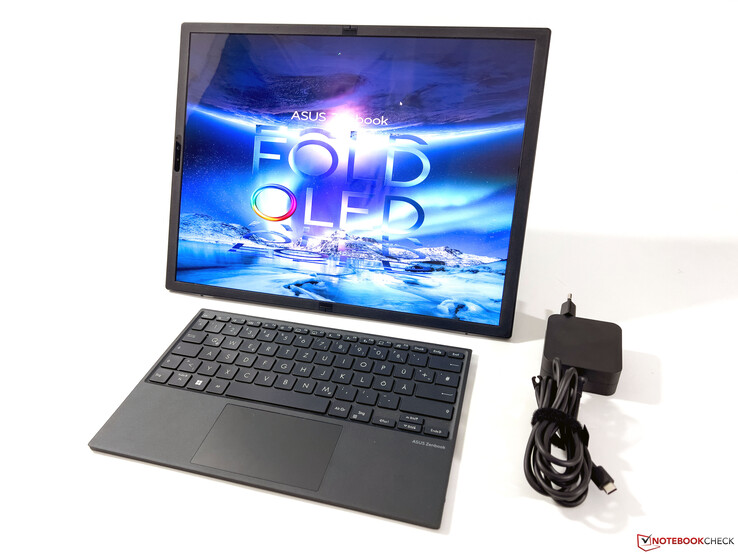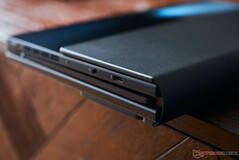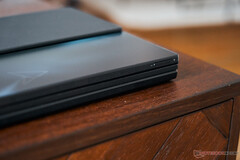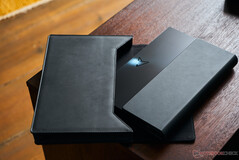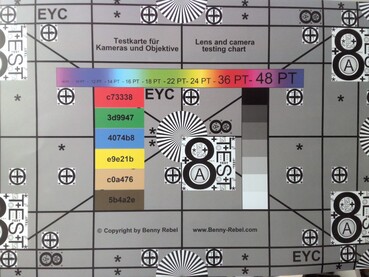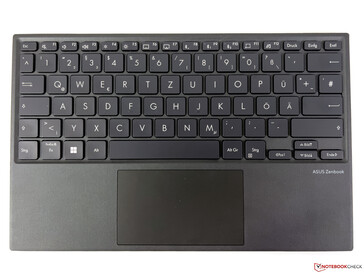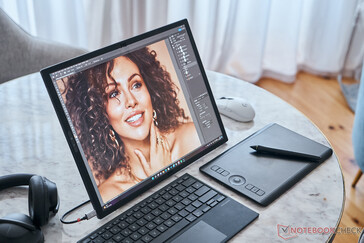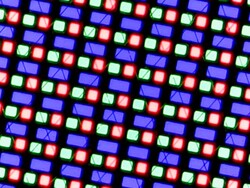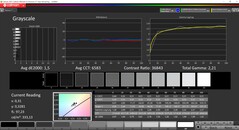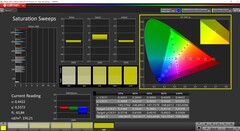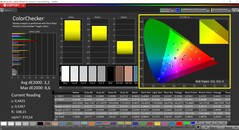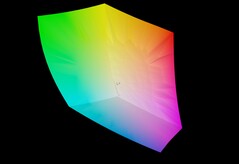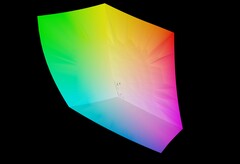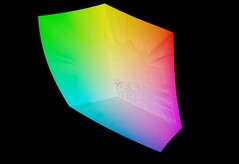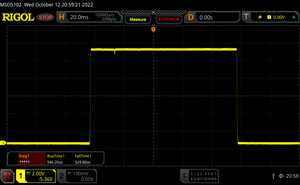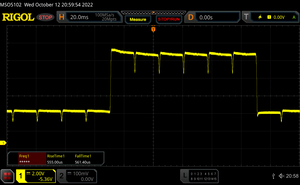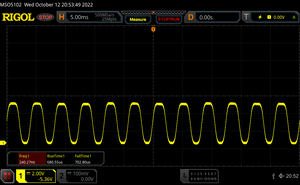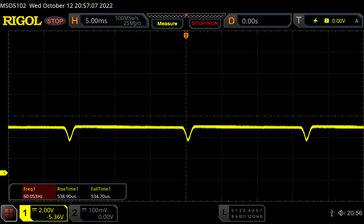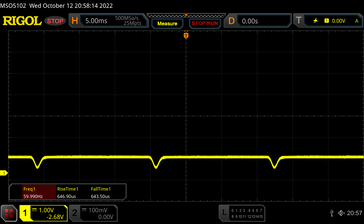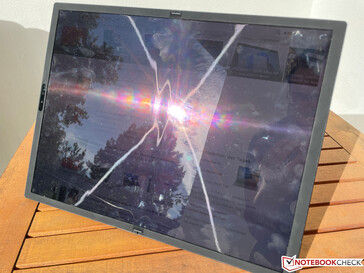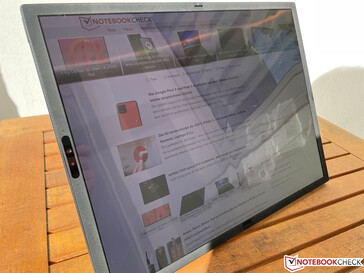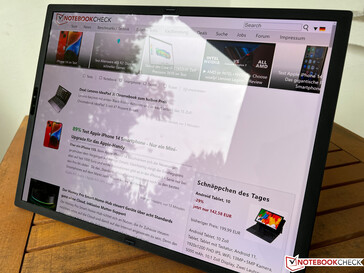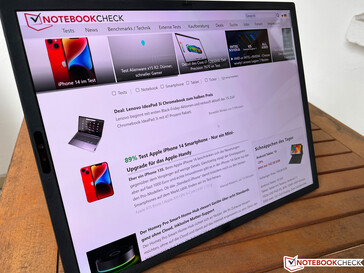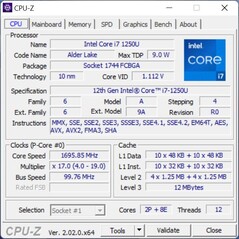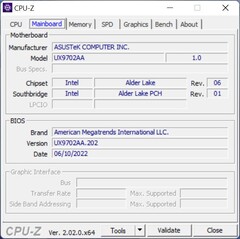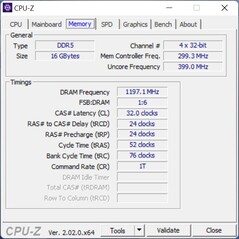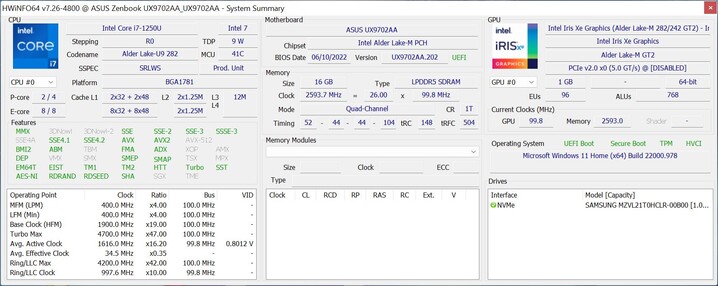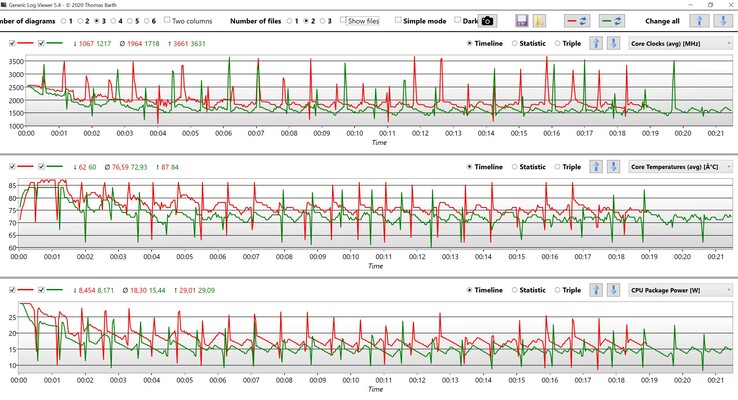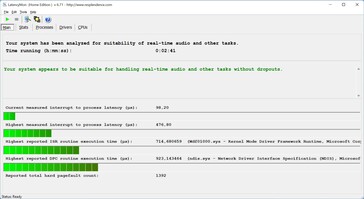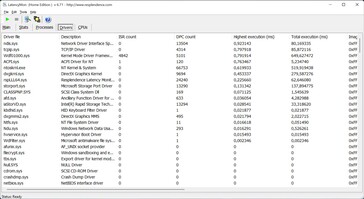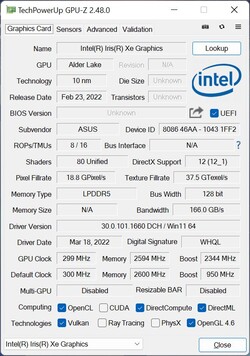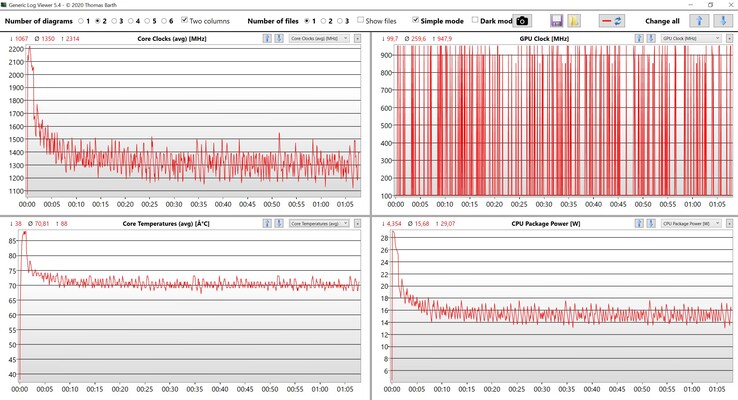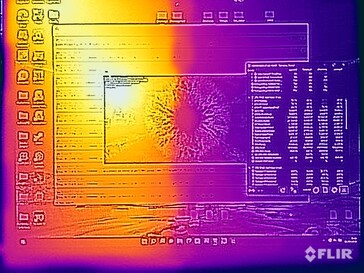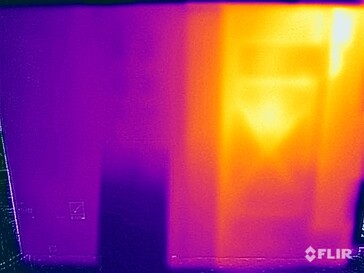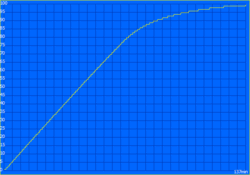Recensione dell'Asus Zenbook 17 Fold - Debutto del convertibile OLED da 17 pollici pieghevole

Sebbene i display pieghevoli non siano più una novità nel mondo degli smartphone, ilThinkPad X1 Fold con uno schermo piuttosto piccolo da 13,3 pollici, che non offre molto spazio soprattutto in modalità laptop, è l'unico rappresentante nel settore dei notebook. Con lo Zenbook Fold, Asus tenta di migliorare la situazione rilasciando un convertibile pieghevole da 17 pollici. Lo schermo OLED ha un rapporto di aspetto 4:3 e una risoluzione nativa di 2560 x 1920 pixel. Il sistema utilizza il Intel Core i7-1250U, un processore Alder Lake-U rilasciato di recente con un TDP di soli 9 watt (fino a 29 watt in Turbo Boost).
Con un prezzo di listino di 3.499 dollari, lo Zenbook 17 Fold non è esattamente un affare. In questa recensione analizzeremo quanto questo grande convertibile pieghevole sia adatto all'uso quotidiano e se sia davvero un valido compagno di viaggio. Sebbene lo Zenbook 17 Fold non abbia attualmente alcun concorrente diretto, Lenovo ha annunciato il nuovo ThinkPad X1 Fold con display OLED da 16 pollici all'IFA di quest'anno.
Potenziali concorrenti a confronto
Punteggio | Data | Modello | Peso | Altezza | Dimensione | Risoluzione | Prezzo |
|---|---|---|---|---|---|---|---|
| 84.5 % v7 (old) | 10/2022 | Asus Zenbook 17 Fold UX9702 i7-1250U, Iris Xe G7 80EUs | 1.8 kg | 12.9 mm | 17.30" | 2560x1920 | |
| 88.7 % v7 (old) | 08/2022 | Lenovo Yoga 7 16IAP7 i7-1260P, Iris Xe G7 96EUs | 2 kg | 19.2 mm | 16.00" | 2560x1600 | |
| 85.8 % v7 (old) | 04/2021 | LG Gram 16 2-in-1 16T90P i7-1165G7, Iris Xe G7 96EUs | 1.5 kg | 17 mm | 16.00" | 2560x1600 | |
| 88.3 % v7 (old) | 06/2020 | Microsoft Surface Book 3 15 i7-1065G7, GeForce GTX 1660 Ti Max-Q | 1.9 kg | 23 mm | 15.00" | 3240x2160 |
I nostri Top 10
» Top 10 Portatili Multimedia
» Top 10 Portatili Gaming
» Top 10 Portatili Gaming Leggeri
» Top 10 Portatili da Ufficio e Business economici
» Top 10 Portatili Premium da Ufficio/Business
» Top 10 Portatili sotto i 300 Euro
» Top 10 Portatili sotto i 500 Euro
» Top 10 dei Portatili Workstation
» Top 10 Subnotebooks
» Top 10 Ultrabooks
» Top 10 Convertibili
» Top 10 Tablets
» Top 10 Tablets Windows
» Top 10 Smartphones
Custodia - Zenbook Fold con telaio in metallo
Dopo l'unboxing iniziale dello Zenbook 17 Fold, gli utenti si troveranno di fronte a un grande tablet da 17 pollici che sembra molto più massiccio dei normali tablet Android o iOS. Il dispositivo è essenzialmente tutto schermo circondato da una cornice gommata con una larghezza di circa 6 mm (~0,24 pollici). La natura metallica della costruzione è evidente sia sul retro che sui bordi e sul retro è presente una copertura aggiuntiva per la cerniera che include un comodo supporto. Lo Zenbook 17 Fold lascia complessivamente un'impressione di qualità superiore e non abbiamo notato alcun difetto nella qualità costruttiva. Tuttavia, la cornice gommata attira la polvere e il touchscreen è piuttosto sensibile alle impronte digitali, anche se possono essere rimosse rapidamente.
Lo Zenbook 17 Fold può essere utilizzato in diversi modi. Sebbene sia possibile utilizzarlo semplicemente come un tablet, l'opzione più comoda è stata quella di posizionarlo su una scrivania per poter lavorare normalmente. La tastiera Bluetooth inclusa o altri dispositivi di input Bluetooth possono essere posizionati davanti ad esso. Inoltre, è possibile utilizzare il convertibile in modalità verticale piegando lo schermo al centro. Infine, il Fold può essere utilizzato anche in modalità laptop. Non appena la tastiera Bluetooth (bloccata magneticamente) viene posizionata sulla metà inferiore del display, la parte inferiore dello schermo OLED si spegne per un'esperienza simile a quella di un tradizionale portatile da 12,5 pollici con 1920 x 1280 pixel e un rapporto di aspetto 3:2. La cerniera lascia un'impronta solida e, secondo Asus, è stata confermata la durata di 30000 cicli. Poiché il case non è destinato ad essere aperto dagli utenti, non ci sono opzioni di manutenzione.
Con un peso totale leggermente superiore a 1,8 kg (1517 g di tablet + 307 g di tastiera), lo Zenbook 17 Fold non è esattamente leggero. Allo stesso modo, il suo spessore di poco superiore a 3 cm (~1,18 pollici) quando è ripiegato significa che non è molto compatto. Pertanto, un portatile tradizionale da 13 pollici è in vantaggio in termini di portabilità. Il caricabatterie da 65 watt pesa altri 225 grammi (circa 0,50 libbre).
Connettività - Zenbook con Thunderbolt 4
Lo Zenbook 17 Fold offre due porte USB Type-C con supporto Thunderbolt 4 e un jack audio da 3,5 mm. Le porte sono state distribuite tenendo conto dei rispettivi casi d'uso. Quando si utilizza il Fold come tablet, una delle porte si trova in basso a sinistra ed è quindi adatta per la ricarica. L'altra porta USB si trova invece nella parte superiore. Sebbene sia ancora accettabile per le chiavette USB, non è esattamente pratica per le unità esterne. In modalità laptop, questa porta si trova al centro sulla destra.
Comunicazione
Asus utilizza il moderno modulo Wi-Fi Intel AX211, che supporta già l'ultimo standard Wi-Fi 6E. Durante i nostri test siamo riusciti a connetterci alla rete a 6 GHz del nostro router di riferimento Asus senza alcun problema e le velocità di trasferimento sono molto elevate. Tuttavia, non è presente un modem LTE o 5G.
| Networking | |
| iperf3 receive AXE11000 6GHz | |
| Asus Zenbook 17 Fold UX9702 | |
| Media Intel Wi-Fi 6E AX211 (700 - 1857, n=224) | |
| Media della classe Convertible (824 - 1763, n=37, ultimi 2 anni) | |
| Lenovo Yoga 7 16IAP7 | |
| iperf3 transmit AXE11000 6GHz | |
| Asus Zenbook 17 Fold UX9702 | |
| Media Intel Wi-Fi 6E AX211 (385 - 1851, n=224) | |
| Media della classe Convertible (685 - 1664, n=35, ultimi 2 anni) | |
| Lenovo Yoga 7 16IAP7 | |
Webcam
Oltre alla telecamera IR per il riconoscimento facciale Windows Hello, Asus integra anche una fotocamera da 5 MP che cattura immagini a 2560 x 1920 pixel (4:3) o 2560 x 1440 pixel (16:9). I video possono essere registrati fino a 1080p con 30 FPS. Rispetto ai moduli tradizionali a 720p o 1080p, la nitidezza delle immagini è notevolmente migliore. Inoltre, sono disponibili un paio di funzioni software come il motive tracking o i filtri di sfondo.
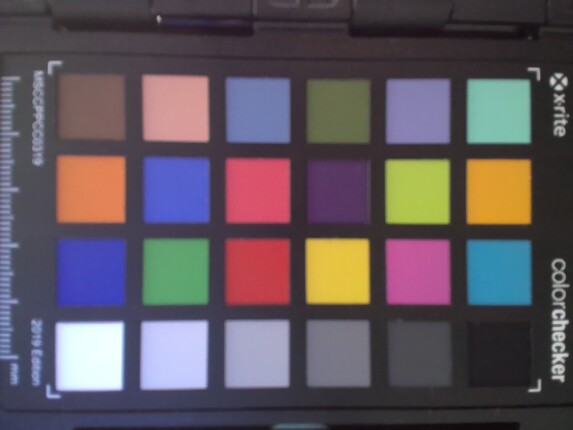
Dispositivi di input - Touchscreen e tastiera Bluetooth
La confezione include una tastiera Bluetooth compatta con clickpad integrato che può essere agganciata magneticamente al tablet, consentendo agli utenti di trasportarla insieme al dispositivo. L'esperienza di digitazione è discreta grazie alla corsa dei tasti di 1,4 mm, ma purtroppo la tastiera non è retroilluminata, il che ha notevoli ripercussioni sull'uso pratico. Il clickpad (10,5 x 6,2 cm) è anch'esso decente e riconosce in modo affidabile i gesti, ma i clic sono piuttosto rumorosi. La tastiera può essere ricaricata tramite USB-C.
Naturalmente, anche il touchscreen capacitivo è disponibile per gli input. Tuttavia, la mancanza ufficiale del supporto per lo stilo, secondo Asus, è una limitazione notevole. La giustificazione del produttore è quella di evitare danni alla superficie dello schermo, che a differenza dei touchscreen tradizionali è privo di strati protettivi aggiuntivi. Sul nostro dispositivo di prova (che è stato utilizzato come dispositivo dimostrativo all'IFA), c'è una leggera ammaccatura nella superficie del display con pixel difettosi. Pertanto, potrebbe esserci qualcosa di vero in questa affermazione e gli utenti dovrebbero maneggiare lo Zenbook 17 Fold con cura. Come per altri smartphone e tablet, è possibile utilizzare le normali penne con punta in gomma.
Display - OLED da 17-Zoll con rapporto d'aspetto 4:3
Lo schermo OLED touchscreen da 17 pollici ha una risoluzione di 2560 x 1920 pixel e un rapporto di aspetto 4:3. Sebbene l'impressione soggettiva sia eccellente, la linea di piegatura al centro può diventare evidente a seconda dell'angolo di visione e dei riflessi, come in altri dispositivi pieghevoli (come gli smartphone). Tuttavia, l'immagine non viene distorta e in pratica non distrae. Il Fold non offre una frequenza di aggiornamento rapida. Gli angoli di visuale sono ottimi e non c'è retroilluminazione grazie al pannello OLED. Asus ha incluso alcune funzioni per contrastare il burn-in delle immagini statiche. Tra queste, l'attivazione di uno screensaver dopo 30 minuti di inattività e il pixel shift, che sposta leggermente i pixel. In pratica non si nota. Oltre alla luminosità, anche la temperatura del colore può essere regolata automaticamente tramite il sensore di luce ambientale.
I risultati delle misurazioni della luminosità corrispondono alle nostre aspettative per gli attuali pannelli OLED dei dispositivi mobili. Abbiamo misurato circa 330 nits in modalità SDR, anche se il rapporto di contrasto è ancora estremamente elevato a causa del basso valore del nero. La modalità HDR (che deve essere attivata manualmente tramite le impostazioni) consente di raggiungere una luminosità di 560 nits in piccole sezioni dello schermo. Quando si visualizza un'immagine quasi interamente luminosa, questo valore scende a ~380 nits.
| |||||||||||||||||||||||||
Distribuzione della luminosità: 95 %
Al centro con la batteria: 332 cd/m²
Contrasto: 33300:1 (Nero: 0.01 cd/m²)
ΔE ColorChecker Calman: 3.2 | ∀{0.5-29.43 Ø4.78}
ΔE Greyscale Calman: 1.5 | ∀{0.09-98 Ø5}
99.6% AdobeRGB 1998 (Argyll 3D)
100% sRGB (Argyll 3D)
99.9% Display P3 (Argyll 3D)
Gamma: 2.21
CCT: 6583 K
| Asus Zenbook 17 Fold UX9702 BOE9C40, OLED, 2560x1920, 17.3" | Lenovo Yoga 7 16IAP7 Lenovo LEN160WQXGA, IPS, 2560x1600, 16" | LG Gram 16 2-in-1 16T90P LG Philips LP160WQ1-SPA1, IPS, 2560x1600, 16" | Microsoft Surface Book 3 15 LG Philips LGD0554, IPS, 3240x2160, 15" | |
|---|---|---|---|---|
| Display | -22% | -6% | -27% | |
| Display P3 Coverage (%) | 99.9 | 67 -33% | 96.3 -4% | 61.5 -38% |
| sRGB Coverage (%) | 100 | 95.7 -4% | 99.9 0% | 92.7 -7% |
| AdobeRGB 1998 Coverage (%) | 99.6 | 69.3 -30% | 84.7 -15% | 63.6 -36% |
| Response Times | -2655% | -2766% | -2754% | |
| Response Time Grey 50% / Grey 80% * (ms) | 1.12 ? | 36 ? -3114% | 36.4 ? -3150% | 38 ? -3293% |
| Response Time Black / White * (ms) | 1.08 ? | 24.8 ? -2196% | 26.8 ? -2381% | 25 ? -2215% |
| PWM Frequency (Hz) | 240 ? | 250 ? | ||
| Screen | -468% | -500% | -299% | |
| Brightness middle (cd/m²) | 333 | 393.7 18% | 325.3 -2% | 428 29% |
| Brightness (cd/m²) | 327 | 367 12% | 311 -5% | 413 26% |
| Brightness Distribution (%) | 95 | 84 -12% | 92 -3% | 89 -6% |
| Black Level * (cd/m²) | 0.01 | 0.38 -3700% | 0.35 -3400% | 0.23 -2200% |
| Contrast (:1) | 33300 | 1036 -97% | 929 -97% | 1861 -94% |
| Colorchecker dE 2000 * | 3.2 | 1.97 38% | 4.91 -53% | 2.65 17% |
| Colorchecker dE 2000 max. * | 8.6 | 5.46 37% | 10.96 -27% | 8.12 6% |
| Greyscale dE 2000 * | 1.5 | 2.1 -40% | 7.7 -413% | 3.99 -166% |
| Gamma | 2.21 100% | 2.1 105% | 2.12 104% | 3.12 71% |
| CCT | 6583 99% | 6461 101% | 8272 79% | 6309 103% |
| Colorchecker dE 2000 calibrated * | 0.62 | 2.83 | 0.92 | |
| Color Space (Percent of AdobeRGB 1998) (%) | 75.8 | 58 | ||
| Color Space (Percent of sRGB) (%) | 99.8 | 93 | ||
| Media totale (Programma / Settaggio) | -1048% /
-702% | -1091% /
-735% | -1027% /
-614% |
* ... Meglio usare valori piccoli
L'applicazione MyAsus contiene diversi profili (sRGB, P3) con "Nativo" come impostazione predefinita. All'inizio, la scala di grigi sembra molto promettente, con basse deviazioni dallo spazio colore di riferimento P3 e una temperatura colore che si avvicina molto al valore ideale. Purtroppo, nella nostra analisi professionale (X-Rite i1 Pro 2) con il software CalMAN abbiamo riscontrato deviazioni cromatiche significative, che rimangono presenti in tutte le altre modalità.
Poiché non siamo riusciti ad attenuare i problemi di deviazione del colore con il nostro tentativo di calibrazione, non possiamo fornire un profilo appropriato. Sebbene il pannello OLED sia ancora adatto all'uso quotidiano, le deviazioni cromatiche sono troppo elevate per un lavoro di editing multimediale serio. Lo spazio colore P3 può essere visualizzato nella sua interezza.
Tempi di risposta del Display
| ↔ Tempi di risposta dal Nero al Bianco | ||
|---|---|---|
| 1.08 ms ... aumenta ↗ e diminuisce ↘ combinato | ↗ 0.55 ms Incremento | |
| ↘ 0.53 ms Calo | ||
| Lo schermo ha mostrato valori di risposta molto veloci nei nostri tests ed è molto adatto per i gaming veloce. In confronto, tutti i dispositivi di test variano da 0.1 (minimo) a 240 (massimo) ms. » 4 % di tutti i dispositivi è migliore. Questo significa che i tempi di risposta rilevati sono migliori rispettto alla media di tutti i dispositivi testati (20.2 ms). | ||
| ↔ Tempo di risposta dal 50% Grigio all'80% Grigio | ||
| 1.12 ms ... aumenta ↗ e diminuisce ↘ combinato | ↗ 0.56 ms Incremento | |
| ↘ 0.56 ms Calo | ||
| Lo schermo ha mostrato valori di risposta molto veloci nei nostri tests ed è molto adatto per i gaming veloce. In confronto, tutti i dispositivi di test variano da 0.165 (minimo) a 636 (massimo) ms. » 4 % di tutti i dispositivi è migliore. Questo significa che i tempi di risposta rilevati sono migliori rispettto alla media di tutti i dispositivi testati (31.6 ms). | ||
Sfarfallio dello schermo / PWM (Pulse-Width Modulation)
| flickering dello schermo / PWM rilevato | 240 Hz | ≤ 65 % settaggio luminosita' | |
Il display sfarfalla a 240 Hz (Probabilmente a causa dell'uso di PWM) Flickering rilevato ad una luminosita' di 65 % o inferiore. Non dovrebbe verificarsi flickering o PWM sopra questo valore di luminosita'. La frequenza di 240 Hz è relativamente bassa, quindi gli utenti sensibili potrebbero notare il flickering ed accusare stanchezza agli occhi a questo livello di luminosità e a livelli inferiori. In confronto: 53 % di tutti i dispositivi testati non utilizza PWM per ridurre la luminosita' del display. Se è rilevato PWM, una media di 8108 (minimo: 5 - massimo: 343500) Hz è stata rilevata. | |||
Abbiamo fatto alcune osservazioni degne di nota sullo sfarfallio PWM. Il tipico e potenzialmente fastidioso sfarfallio a 240 Hz è presente a tutti i livelli di luminosità da 0 a 65%. Dal 66 al 99% viene utilizzato il dimming DC e non abbiamo rilevato alcuno sfarfallio al 100% della luminosità. Sebbene la frequenza di dimmerazione CC sia di soli 60 Hz, l'ampiezza ridotta rende questo sfarfallio molto meno problematico.
Come su altri dispositivi Asus con pannelli OLED, è presente una funzione software chiamata flicker-free OLED, che riduce lo sfarfallio anche con impostazioni di luminosità inferiori. Non appena l'utente diminuisce la luminosità, viene visualizzato un suggerimento che consiglia di evitare di impostare la normale luminosità di Windows al di sotto del 60% e di utilizzare invece il software per ridurre ulteriormente la luminanza del pannello, passo dopo passo. In questo modo il DC dimming rimane abilitato per evitare il problematico sfarfallio a 240 Hz. Contrariamente a quanto raccomandato da Asus, tuttavia, la luminosità di Windows deve essere lasciata scendere sotto il 70%. La funzione funziona, anche se una soluzione completamente integrata sarebbe stata meno fastidiosa.
L'uso all'aperto dipende in larga misura dalla luminosità dell'ambiente e dalla presenza del sole. Nelle giornate nuvolose, i riflessi sono ancora evidenti, ma di solito tutto ciò che appare sullo schermo rimane distinguibile. Sotto la luce del sole, la luminosità relativamente bassa dell'SDR può diventare un problema, poiché non è in grado di compensare adeguatamente i riflessi e i bagliori.
Prestazioni - Zenbook 17 Fold con una CPU Alder Lake ad alta efficienza energetica
Asus offre attualmente solo una configurazione dello Zenbook 17 Fold con un processore Intel Core i7, 16 GB di RAM e un SSD PCIe da 1 TB. Invece di un normale chip Alder Lake-U, il laptop si affida a un chip particolarmente efficiente dal punto di vista energetico (precedentemente denominato ULV). Secondo Intel, il Core i7-1250U raggiunge un consumo di picco di 29 watt e un TDP tipico di soli 9 watt.
Condizioni di test
All'interno dell'applicazione MyAsus è possibile selezionare diversi profili di risparmio energetico (modalità silenziosa, modalità standard, modalità prestazioni), mentre la modalità standard è quella predefinita. Sebbene tutti e tre i profili siano generalmente adatti all'uso quotidiano, la modalità prestazioni è consigliata per i giochi, in quanto vi sono differenze significative in termini di prestazioni della GPU. Tuttavia, le ventole sono più rumorose in questa modalità. La tabella seguente mostra i rispettivi valori di TDP. Sebbene abbiamo eseguito tutti i benchmark e le misurazioni utilizzando la modalità Performance, determineremo anche l'impatto delle altre modalità, se necessario.
| Profilo di potenza | CPU PL2 | CPU PL1 | Rumore di picco della ventola |
|---|---|---|---|
| Modalità silenziosa | 29 watt | ~10,5 watt | non percepibile |
| Modalità standard | 29 watt | ~14 watt | 27,9 dB(A) |
| Modalità Performance | 29 watt | ~16 watt | 43,4 dB(A) |
Processore - Intel Core i7-1250U
Il Core i7-1250U è un processore Alder Lake-U con due core ad alte prestazioni e otto core di efficienza (10 core e 12 thread in totale). Tuttavia, i limiti di potenza rispetto al "normale" Core i7-1255U sono inferiori e Asus si attiene alle specifiche Intel di 29 watt di picco di consumo. In condizioni di carico prolungato, l'assorbimento di potenza rimane nell'intervallo 16-16 watt, un risultato abbastanza decente se si considerano le impostazioni del TDP. Quando si imposta la modalità standard, le prestazioni della CPU subiscono un leggero calo che, a differenza della ventola più silenziosa, non si nota. Le prestazioni rimangono costanti anche in modalità batteria; altri benchmark della CPU sono disponibili nella nostra pagina Pagina dei benchmark della CPU.
Cinebench R15 Multi Loop
Cinebench R23: Multi Core | Single Core
Cinebench R20: CPU (Multi Core) | CPU (Single Core)
Cinebench R15: CPU Multi 64Bit | CPU Single 64Bit
Blender: v2.79 BMW27 CPU
7-Zip 18.03: 7z b 4 | 7z b 4 -mmt1
Geekbench 5.5: Multi-Core | Single-Core
HWBOT x265 Benchmark v2.2: 4k Preset
LibreOffice : 20 Documents To PDF
R Benchmark 2.5: Overall mean
| CPU Performance rating | |
| Media della classe Convertible | |
| Lenovo Yoga 7 16IAP7 | |
| Asus Zenbook 17 Fold UX9702 | |
| Media Intel Core i7-1250U | |
| LG Gram 16 2-in-1 16T90P | |
| Microsoft Surface Book 3 15 -2! | |
| Cinebench R23 / Multi Core | |
| Media della classe Convertible (2949 - 29063, n=56, ultimi 2 anni) | |
| Lenovo Yoga 7 16IAP7 | |
| Media Intel Core i7-1250U (7021 - 7735, n=3) | |
| Asus Zenbook 17 Fold UX9702 | |
| LG Gram 16 2-in-1 16T90P | |
| Cinebench R23 / Single Core | |
| Lenovo Yoga 7 16IAP7 | |
| Media della classe Convertible (914 - 2163, n=56, ultimi 2 anni) | |
| Media Intel Core i7-1250U (1561 - 1606, n=3) | |
| Asus Zenbook 17 Fold UX9702 | |
| LG Gram 16 2-in-1 16T90P | |
| Cinebench R20 / CPU (Multi Core) | |
| Media della classe Convertible (1124 - 11357, n=56, ultimi 2 anni) | |
| Lenovo Yoga 7 16IAP7 | |
| Media Intel Core i7-1250U (2745 - 2970, n=3) | |
| Asus Zenbook 17 Fold UX9702 | |
| LG Gram 16 2-in-1 16T90P | |
| Microsoft Surface Book 3 15 | |
| Cinebench R20 / CPU (Single Core) | |
| Media della classe Convertible (348 - 827, n=56, ultimi 2 anni) | |
| Lenovo Yoga 7 16IAP7 | |
| Asus Zenbook 17 Fold UX9702 | |
| Media Intel Core i7-1250U (605 - 621, n=3) | |
| LG Gram 16 2-in-1 16T90P | |
| Microsoft Surface Book 3 15 | |
| Cinebench R15 / CPU Multi 64Bit | |
| Media della classe Convertible (478 - 4830, n=59, ultimi 2 anni) | |
| Lenovo Yoga 7 16IAP7 | |
| Asus Zenbook 17 Fold UX9702 | |
| Asus Zenbook 17 Fold UX9702 | |
| Media Intel Core i7-1250U (1085 - 1297, n=4) | |
| LG Gram 16 2-in-1 16T90P | |
| Microsoft Surface Book 3 15 | |
| Cinebench R15 / CPU Single 64Bit | |
| Media della classe Convertible (149.8 - 317, n=56, ultimi 2 anni) | |
| Lenovo Yoga 7 16IAP7 | |
| Asus Zenbook 17 Fold UX9702 | |
| Media Intel Core i7-1250U (218 - 226, n=3) | |
| LG Gram 16 2-in-1 16T90P | |
| Microsoft Surface Book 3 15 | |
| Blender / v2.79 BMW27 CPU | |
| Microsoft Surface Book 3 15 | |
| LG Gram 16 2-in-1 16T90P | |
| Asus Zenbook 17 Fold UX9702 | |
| Media Intel Core i7-1250U (411 - 556, n=3) | |
| Lenovo Yoga 7 16IAP7 | |
| Media della classe Convertible (107 - 1051, n=55, ultimi 2 anni) | |
| 7-Zip 18.03 / 7z b 4 | |
| Lenovo Yoga 7 16IAP7 | |
| Media della classe Convertible (12977 - 121368, n=56, ultimi 2 anni) | |
| Asus Zenbook 17 Fold UX9702 | |
| Media Intel Core i7-1250U (27072 - 31934, n=3) | |
| LG Gram 16 2-in-1 16T90P | |
| Microsoft Surface Book 3 15 | |
| 7-Zip 18.03 / 7z b 4 -mmt1 | |
| Lenovo Yoga 7 16IAP7 | |
| Media della classe Convertible (3672 - 6540, n=56, ultimi 2 anni) | |
| LG Gram 16 2-in-1 16T90P | |
| Media Intel Core i7-1250U (4755 - 5041, n=3) | |
| Asus Zenbook 17 Fold UX9702 | |
| Microsoft Surface Book 3 15 | |
| Geekbench 5.5 / Multi-Core | |
| Lenovo Yoga 7 16IAP7 | |
| Media della classe Convertible (2188 - 22023, n=55, ultimi 2 anni) | |
| Asus Zenbook 17 Fold UX9702 | |
| Media Intel Core i7-1250U (6753 - 7092, n=3) | |
| LG Gram 16 2-in-1 16T90P | |
| Microsoft Surface Book 3 15 | |
| Geekbench 5.5 / Single-Core | |
| Media della classe Convertible (806 - 2275, n=55, ultimi 2 anni) | |
| Lenovo Yoga 7 16IAP7 | |
| Asus Zenbook 17 Fold UX9702 | |
| Media Intel Core i7-1250U (1584 - 1670, n=3) | |
| LG Gram 16 2-in-1 16T90P | |
| Microsoft Surface Book 3 15 | |
| HWBOT x265 Benchmark v2.2 / 4k Preset | |
| Media della classe Convertible (3.43 - 36.2, n=56, ultimi 2 anni) | |
| Lenovo Yoga 7 16IAP7 | |
| Media Intel Core i7-1250U (7.84 - 8.97, n=3) | |
| Asus Zenbook 17 Fold UX9702 | |
| LG Gram 16 2-in-1 16T90P | |
| Microsoft Surface Book 3 15 | |
| LibreOffice / 20 Documents To PDF | |
| Microsoft Surface Book 3 15 | |
| Media Intel Core i7-1250U (51.8 - 53.8, n=3) | |
| Media della classe Convertible (42.5 - 84.3, n=55, ultimi 2 anni) | |
| Asus Zenbook 17 Fold UX9702 | |
| LG Gram 16 2-in-1 16T90P | |
| Lenovo Yoga 7 16IAP7 | |
| R Benchmark 2.5 / Overall mean | |
| Microsoft Surface Book 3 15 | |
| LG Gram 16 2-in-1 16T90P | |
| Media Intel Core i7-1250U (0.504 - 0.538, n=3) | |
| Asus Zenbook 17 Fold UX9702 | |
| Media della classe Convertible (0.3985 - 0.84, n=55, ultimi 2 anni) | |
| Lenovo Yoga 7 16IAP7 | |
* ... Meglio usare valori piccoli
AIDA64: FP32 Ray-Trace | FPU Julia | CPU SHA3 | CPU Queen | FPU SinJulia | FPU Mandel | CPU AES | CPU ZLib | FP64 Ray-Trace | CPU PhotoWorxx
| Performance rating | |
| Media della classe Convertible | |
| Lenovo Yoga 7 16IAP7 | |
| LG Gram 16 2-in-1 16T90P | |
| Asus Zenbook 17 Fold UX9702 | |
| Media Intel Core i7-1250U | |
| Microsoft Surface Book 3 15 | |
| AIDA64 / FP32 Ray-Trace | |
| Media della classe Convertible (1480 - 64158, n=55, ultimi 2 anni) | |
| Lenovo Yoga 7 16IAP7 | |
| LG Gram 16 2-in-1 16T90P | |
| Media Intel Core i7-1250U (5093 - 7187, n=3) | |
| Asus Zenbook 17 Fold UX9702 | |
| Microsoft Surface Book 3 15 | |
| AIDA64 / FPU Julia | |
| Media della classe Convertible (11392 - 183760, n=55, ultimi 2 anni) | |
| Lenovo Yoga 7 16IAP7 | |
| Asus Zenbook 17 Fold UX9702 | |
| Media Intel Core i7-1250U (25253 - 35312, n=3) | |
| LG Gram 16 2-in-1 16T90P | |
| Microsoft Surface Book 3 15 | |
| AIDA64 / CPU SHA3 | |
| Media della classe Convertible (797 - 8151, n=55, ultimi 2 anni) | |
| Lenovo Yoga 7 16IAP7 | |
| LG Gram 16 2-in-1 16T90P | |
| Asus Zenbook 17 Fold UX9702 | |
| Media Intel Core i7-1250U (1296 - 1840, n=3) | |
| Microsoft Surface Book 3 15 | |
| AIDA64 / CPU Queen | |
| Lenovo Yoga 7 16IAP7 | |
| Media della classe Convertible (14686 - 145339, n=55, ultimi 2 anni) | |
| Media Intel Core i7-1250U (53235 - 53961, n=3) | |
| Asus Zenbook 17 Fold UX9702 | |
| LG Gram 16 2-in-1 16T90P | |
| Microsoft Surface Book 3 15 | |
| AIDA64 / FPU SinJulia | |
| Media della classe Convertible (1120 - 29155, n=55, ultimi 2 anni) | |
| Lenovo Yoga 7 16IAP7 | |
| LG Gram 16 2-in-1 16T90P | |
| Media Intel Core i7-1250U (3617 - 4347, n=3) | |
| Asus Zenbook 17 Fold UX9702 | |
| Microsoft Surface Book 3 15 | |
| AIDA64 / FPU Mandel | |
| Media della classe Convertible (4929 - 97193, n=55, ultimi 2 anni) | |
| Lenovo Yoga 7 16IAP7 | |
| LG Gram 16 2-in-1 16T90P | |
| Asus Zenbook 17 Fold UX9702 | |
| Media Intel Core i7-1250U (12480 - 17594, n=3) | |
| Microsoft Surface Book 3 15 | |
| AIDA64 / CPU AES | |
| LG Gram 16 2-in-1 16T90P | |
| Media della classe Convertible (15752 - 139734, n=55, ultimi 2 anni) | |
| Lenovo Yoga 7 16IAP7 | |
| Asus Zenbook 17 Fold UX9702 | |
| Media Intel Core i7-1250U (26729 - 36135, n=3) | |
| Microsoft Surface Book 3 15 | |
| AIDA64 / CPU ZLib | |
| Media della classe Convertible (218 - 2001, n=55, ultimi 2 anni) | |
| Lenovo Yoga 7 16IAP7 | |
| Asus Zenbook 17 Fold UX9702 | |
| Media Intel Core i7-1250U (391 - 550, n=3) | |
| LG Gram 16 2-in-1 16T90P | |
| Microsoft Surface Book 3 15 | |
| AIDA64 / FP64 Ray-Trace | |
| Media della classe Convertible (1169 - 34297, n=55, ultimi 2 anni) | |
| Lenovo Yoga 7 16IAP7 | |
| LG Gram 16 2-in-1 16T90P | |
| Media Intel Core i7-1250U (2687 - 3755, n=3) | |
| Asus Zenbook 17 Fold UX9702 | |
| Microsoft Surface Book 3 15 | |
| AIDA64 / CPU PhotoWorxx | |
| LG Gram 16 2-in-1 16T90P | |
| Media della classe Convertible (14193 - 81626, n=55, ultimi 2 anni) | |
| Lenovo Yoga 7 16IAP7 | |
| Asus Zenbook 17 Fold UX9702 | |
| Media Intel Core i7-1250U (31653 - 36020, n=3) | |
| Microsoft Surface Book 3 15 | |
Prestazioni del sistema
Durante l'uso quotidiano, lo Zenbook 17 Fold è un dispositivo reattivo, in parte grazie al veloce SSD PCIe. Anche i risultati dei benchmark sono discreti. Anche i risultati dei benchmark sono discreti. Il fatto che Windows non sia stato ottimizzato per gli input tattili diventa subito evidente nella pratica. Detto questo, sono stati fatti notevoli passi avanti rispetto a Windows 10 e al vecchio ThinkPad X1 Fold e la distribuzione delle finestre tra gli schermi è notevolmente migliorata sull'Asus. Il passaggio alla modalità laptop quando si posiziona la tastiera sulla parte inferiore (che disabilita lo schermo in quell'area) funziona bene e il posizionamento delle icone del desktop rimane coerente. Solo le finestre devono essere ridimensionate frequentemente e le applicazioni attive non cambiano sempre di dimensione.
CrossMark: Overall | Productivity | Creativity | Responsiveness
| PCMark 10 / Score | |
| Media della classe Convertible (3229 - 9125, n=53, ultimi 2 anni) | |
| Lenovo Yoga 7 16IAP7 | |
| Asus Zenbook 17 Fold UX9702 | |
| Media Intel Core i7-1250U, Intel Iris Xe Graphics G7 80EUs (n=1) | |
| LG Gram 16 2-in-1 16T90P | |
| Microsoft Surface Book 3 15 | |
| PCMark 10 / Essentials | |
| Lenovo Yoga 7 16IAP7 | |
| Media della classe Convertible (7233 - 12222, n=53, ultimi 2 anni) | |
| Asus Zenbook 17 Fold UX9702 | |
| Media Intel Core i7-1250U, Intel Iris Xe Graphics G7 80EUs (n=1) | |
| LG Gram 16 2-in-1 16T90P | |
| Microsoft Surface Book 3 15 | |
| PCMark 10 / Productivity | |
| Media della classe Convertible (5062 - 10643, n=53, ultimi 2 anni) | |
| Lenovo Yoga 7 16IAP7 | |
| Asus Zenbook 17 Fold UX9702 | |
| Media Intel Core i7-1250U, Intel Iris Xe Graphics G7 80EUs (n=1) | |
| LG Gram 16 2-in-1 16T90P | |
| Microsoft Surface Book 3 15 | |
| PCMark 10 / Digital Content Creation | |
| Media della classe Convertible (2496 - 16551, n=53, ultimi 2 anni) | |
| Lenovo Yoga 7 16IAP7 | |
| LG Gram 16 2-in-1 16T90P | |
| Asus Zenbook 17 Fold UX9702 | |
| Media Intel Core i7-1250U, Intel Iris Xe Graphics G7 80EUs (n=1) | |
| Microsoft Surface Book 3 15 | |
| CrossMark / Overall | |
| Lenovo Yoga 7 16IAP7 | |
| Media della classe Convertible (524 - 2274, n=56, ultimi 2 anni) | |
| Asus Zenbook 17 Fold UX9702 | |
| Media Intel Core i7-1250U, Intel Iris Xe Graphics G7 80EUs (n=1) | |
| CrossMark / Productivity | |
| Lenovo Yoga 7 16IAP7 | |
| Media della classe Convertible (554 - 1925, n=56, ultimi 2 anni) | |
| Asus Zenbook 17 Fold UX9702 | |
| Media Intel Core i7-1250U, Intel Iris Xe Graphics G7 80EUs (n=1) | |
| CrossMark / Creativity | |
| Lenovo Yoga 7 16IAP7 | |
| Media della classe Convertible (550 - 2949, n=56, ultimi 2 anni) | |
| Asus Zenbook 17 Fold UX9702 | |
| Media Intel Core i7-1250U, Intel Iris Xe Graphics G7 80EUs (n=1) | |
| CrossMark / Responsiveness | |
| Lenovo Yoga 7 16IAP7 | |
| Media della classe Convertible (381 - 1719, n=56, ultimi 2 anni) | |
| Asus Zenbook 17 Fold UX9702 | |
| Media Intel Core i7-1250U, Intel Iris Xe Graphics G7 80EUs (n=1) | |
| PCMark 10 Score | 4998 punti | |
Aiuto | ||
| AIDA64 / Memory Copy | |
| Media della classe Convertible (23880 - 158525, n=55, ultimi 2 anni) | |
| Lenovo Yoga 7 16IAP7 | |
| LG Gram 16 2-in-1 16T90P | |
| Asus Zenbook 17 Fold UX9702 | |
| Media Intel Core i7-1250U (54484 - 61468, n=3) | |
| Microsoft Surface Book 3 15 | |
| AIDA64 / Memory Read | |
| Media della classe Convertible (19931 - 126725, n=55, ultimi 2 anni) | |
| Lenovo Yoga 7 16IAP7 | |
| LG Gram 16 2-in-1 16T90P | |
| Media Intel Core i7-1250U (50867 - 56328, n=3) | |
| Microsoft Surface Book 3 15 | |
| Asus Zenbook 17 Fold UX9702 | |
| AIDA64 / Memory Write | |
| Media della classe Convertible (17473 - 216896, n=55, ultimi 2 anni) | |
| LG Gram 16 2-in-1 16T90P | |
| Media Intel Core i7-1250U (59356 - 65429, n=3) | |
| Asus Zenbook 17 Fold UX9702 | |
| Lenovo Yoga 7 16IAP7 | |
| Microsoft Surface Book 3 15 | |
| AIDA64 / Memory Latency | |
| Asus Zenbook 17 Fold UX9702 | |
| Media della classe Convertible (6.9 - 536, n=54, ultimi 2 anni) | |
| Media Intel Core i7-1250U (89.3 - 145.7, n=3) | |
| Lenovo Yoga 7 16IAP7 | |
| LG Gram 16 2-in-1 16T90P | |
| Microsoft Surface Book 3 15 | |
* ... Meglio usare valori piccoli
Latenza DPC
| DPC Latencies / LatencyMon - interrupt to process latency (max), Web, Youtube, Prime95 | |
| Microsoft Surface Book 3 15 | |
| LG Gram 16 2-in-1 16T90P | |
| Lenovo Yoga 7 16IAP7 | |
| Asus Zenbook 17 Fold UX9702 | |
* ... Meglio usare valori piccoli
Soluzione di stoccaggio
Asus utilizza un veloce SSD Samsung PCIe-4.0 (PM9A1) con una capacità di 1 TB. Dopo la prima configurazione del dispositivo, l'utente ha a disposizione circa 905 GB. Sebbene le velocità di trasferimento siano eccellenti, superiori a 6 GB/s, le prestazioni calano drasticamente dopo pochi minuti. Questo non dovrebbe influire sul normale utilizzo e non abbiamo notato alcuna limitazione durante i nostri test. I problemi sono probabilmente dovuti alla temperatura e sono un problema di gran parte delle unità SSD PCIe-4.0 veloci. Ulteriori benchmark sulle SSD sono disponibili qui.
| Drive Performance rating - Percent | |
| Media Samsung PM9A1 MZVL21T0HCLR | |
| Asus Zenbook 17 Fold UX9702 | |
| Media della classe Convertible | |
| LG Gram 16 2-in-1 16T90P | |
| Lenovo Yoga 7 16IAP7 | |
| Microsoft Surface Book 3 15 | |
* ... Meglio usare valori piccoli
Disk Throttling: DiskSpd Read Loop, Queue Depth 8
Prestazioni della GPU
Una peculiarità del Core i7-1250U è la sua iGPU leggermente più lenta, più precisamente l'unità grafica Iris Xe Graphics G7 con 80 UE (clock del core fino a 950 MHz), integrata anche in molti processori Core i5. Durante l'uso quotidiano, le prestazioni sono comunque sufficienti e i video ad alta risoluzione possono essere guardati senza problemi. Dal momento che lo Zenbook 17 Fold fatica a far girare in modo fluido molti titoli anche a basse impostazioni, è poco adatto al gioco. Raccomandiamo la modalità Performance agli utenti che vogliono giocare, poiché le altre modalità comportano un deficit di prestazioni della GPU di circa il 50%. Per i giochi a casa, è possibile collegare una GPU esterna tramite Thunderbolt, anche se va notato che il processore potrebbe diventare un collo di bottiglia per le soluzioni esterne più veloci.
Le prestazioni della GPU sono costanti sia in condizioni di stress prolungato che in modalità batteria. Ulteriori benchmark della GPU sono disponibili qui.
| 3DMark 11 Performance | 5407 punti | |
| 3DMark Cloud Gate Standard Score | 17149 punti | |
| 3DMark Fire Strike Score | 3379 punti | |
| 3DMark Time Spy Score | 1474 punti | |
Aiuto | ||
Witcher 3 FPS Graph
| basso | medio | alto | ultra | |
|---|---|---|---|---|
| GTA V (2015) | 75.1 | 44.1 | 8.19 | |
| The Witcher 3 (2015) | 73 | 47 | 25 | 9.47 |
| Dota 2 Reborn (2015) | 34 | 21.1 | 10.4 | 9.3 |
| Final Fantasy XV Benchmark (2018) | 16 | 4.47 | 4.01 | |
| X-Plane 11.11 (2018) | 23.7 | 13.7 | ||
| Far Cry 5 (2018) | 14 | 9 | ||
| Strange Brigade (2018) | 22.7 | 6 | ||
| F1 2021 (2021) | 15.6 | |||
| Farming Simulator 22 (2021) | 16 | |||
| F1 22 (2022) | 11 |
Emissioni - Zenbook Fold rimane molto silenzioso
Emissioni sonore
Lo Zenbook 17 Fold è generalmente molto silenzioso, con le ventole che sussurrano a ~28 dB(A) in condizioni di massimo stress se impostate sulla modalità standard e di riposo in idle se impostate sulla modalità silenziosa. Durante il gioco, la modalità prestazioni è essenzialmente obbligatoria, con un notevole aumento di 43 dB(A). Non abbiamo notato alcun rumore elettronico o di bobina.
Rumorosità
| Idle |
| 24.3 / 24.3 / 24.3 dB(A) |
| Sotto carico |
| 27.9 / 43.4 dB(A) |
 | ||
30 dB silenzioso 40 dB(A) udibile 50 dB(A) rumoroso |
||
min: | ||
| Asus Zenbook 17 Fold UX9702 Iris Xe G7 80EUs, i7-1250U, Samsung PM9A1 MZVL21T0HCLR | Lenovo Yoga 7 16IAP7 Iris Xe G7 96EUs, i7-1260P, Micron 2450 512GB MTFDKCD512TFK | LG Gram 16 2-in-1 16T90P Iris Xe G7 96EUs, i7-1165G7, SK Hynix PC401 512GB M.2 (HFS512GD9TNG) | Microsoft Surface Book 3 15 GeForce GTX 1660 Ti Max-Q, i7-1065G7, SK hynix BC501 HFM256GDGTNG | |
|---|---|---|---|---|
| Noise | -2% | -0% | -14% | |
| off /ambiente * (dB) | 23.4 | 23.6 -1% | 25.1 -7% | 30.2 -29% |
| Idle Minimum * (dB) | 24.3 | 23.6 3% | 25.2 -4% | 30.2 -24% |
| Idle Average * (dB) | 24.3 | 23.6 3% | 25.2 -4% | 30.2 -24% |
| Idle Maximum * (dB) | 24.3 | 23.6 3% | 25.2 -4% | 30.2 -24% |
| Load Average * (dB) | 27.9 | 37.7 -35% | 32.1 -15% | 30.9 -11% |
| Witcher 3 ultra * (dB) | 43.4 | 40 8% | 34.9 20% | 45.1 -4% |
| Load Maximum * (dB) | 43.4 | 40.2 7% | 37.8 13% | 34.3 21% |
* ... Meglio usare valori piccoli
Temperatura
La scheda madre, il processore e il raffreddamento si trovano nella metà sinistra del case (quando viene utilizzato in modalità tablet), ma le temperature superficiali rimangono ragionevoli. Le temperature aumentano appena durante l'uso quotidiano e anche in condizioni di massimo stress, abbiamo misurato solo 44 °C (111,2 °F) e ~42 °C (107,6 °F) sulla parte anteriore e posteriore, rispettivamente. Nella maggior parte degli scenari, è improbabile che gli utenti entrino in contatto con queste aree, ad esempio in modalità laptop o quando il tablet viene appoggiato su un tavolo.
Durante il nostro stress test, il clock della GPU fluttua ampiamente, mentre le prestazioni della CPU rimangono costanti. Le prestazioni non calano direttamente dopo lo stress test.
(±) La temperatura massima sul lato superiore è di 44.5 °C / 112 F, rispetto alla media di 35.4 °C / 96 F, che varia da 19.6 a 60 °C per questa classe Convertible.
(±) Il lato inferiore si riscalda fino ad un massimo di 41.8 °C / 107 F, rispetto alla media di 36.8 °C / 98 F
(+) In idle, la temperatura media del lato superiore è di 25.2 °C / 77 F, rispetto alla media deld ispositivo di 30.3 °C / 87 F.
(±) Riproducendo The Witcher 3, la temperatura media per il lato superiore e' di 34.6 °C / 94 F, rispetto alla media del dispositivo di 30.3 °C / 87 F.
(±) I poggiapolsi e il touchpad possono diventare molto caldi al tatto con un massimo di 37.8 °C / 100 F.
(-) La temperatura media della zona del palmo della mano di dispositivi simili e'stata di 27.9 °C / 82.2 F (-9.9 °C / -17.8 F).
| Asus Zenbook 17 Fold UX9702 Intel Core i7-1250U, Intel Iris Xe Graphics G7 80EUs | Lenovo Yoga 7 16IAP7 Intel Core i7-1260P, Intel Iris Xe Graphics G7 96EUs | LG Gram 16 2-in-1 16T90P Intel Core i7-1165G7, Intel Iris Xe Graphics G7 96EUs | Microsoft Surface Book 3 15 Intel Core i7-1065G7, NVIDIA GeForce GTX 1660 Ti Max-Q | |
|---|---|---|---|---|
| Heat | 18% | -2% | -8% | |
| Maximum Upper Side * (°C) | 44.5 | 39 12% | 42.2 5% | 41.4 7% |
| Maximum Bottom * (°C) | 41.8 | 34.2 18% | 46.2 -11% | 39.7 5% |
| Idle Upper Side * (°C) | 28.9 | 21.2 27% | 26 10% | 34.6 -20% |
| Idle Bottom * (°C) | 24.7 | 21.6 13% | 27.6 -12% | 30.3 -23% |
* ... Meglio usare valori piccoli
Altoparlanti
Sono presenti quattro altoparlanti distribuiti su entrambi i lati. Se questo permette di ottenere un effetto stereo decente in modalità tablet, la modalità laptop è un'altra storia (dato che gli altoparlanti sono posizionati sui bordi superiore e inferiore). Il sistema viene fornito con l'applicazione Dolby e consigliamo di attivarne gli effetti, poiché altrimenti il suono è relativamente sottile. Con gli effetti Dolby attivati (sono disponibili vari profili), il suono è piacevolmente pieno e ricco, con solo le frequenze basse più limitate. Per il consumo occasionale di musica e video, la qualità è più che sufficiente e gli utenti non dovranno necessariamente ricorrere ad altoparlanti o cuffie esterne.
Asus Zenbook 17 Fold UX9702 analisi audio
(±) | potenza degli altiparlanti media ma buona (80 dB)
Bassi 100 - 315 Hz
(±) | bassi ridotti - in media 7.2% inferiori alla media
(±) | la linearità dei bassi è media (10.3% delta rispetto alla precedente frequenza)
Medi 400 - 2000 Hz
(±) | medi elevati - circa 7.2% superiore alla media
(+) | medi lineari (6.6% delta rispetto alla precedente frequenza)
Alti 2 - 16 kHz
(+) | Alti bilanciati - appena 3.3% dalla media
(+) | alti lineari (6.2% delta rispetto alla precedente frequenza)
Nel complesso 100 - 16.000 Hz
(+) | suono nel complesso lineare (14.5% differenza dalla media)
Rispetto alla stessa classe
» 22% di tutti i dispositivi testati in questa classe è stato migliore, 4% simile, 74% peggiore
» Il migliore ha avuto un delta di 6%, medio di 20%, peggiore di 57%
Rispetto a tutti i dispositivi testati
» 18% di tutti i dispositivi testati in questa classe è stato migliore, 4% similare, 78% peggiore
» Il migliore ha avuto un delta di 4%, medio di 24%, peggiore di 134%
Lenovo Yoga 7 16IAP7 analisi audio
(+) | gli altoparlanti sono relativamente potenti (84.7 dB)
Bassi 100 - 315 Hz
(±) | bassi ridotti - in media 13.4% inferiori alla media
(±) | la linearità dei bassi è media (8.6% delta rispetto alla precedente frequenza)
Medi 400 - 2000 Hz
(±) | medi elevati - circa 5.7% superiore alla media
(+) | medi lineari (6.4% delta rispetto alla precedente frequenza)
Alti 2 - 16 kHz
(+) | Alti bilanciati - appena 3.9% dalla media
(+) | alti lineari (6% delta rispetto alla precedente frequenza)
Nel complesso 100 - 16.000 Hz
(+) | suono nel complesso lineare (13.2% differenza dalla media)
Rispetto alla stessa classe
» 17% di tutti i dispositivi testati in questa classe è stato migliore, 3% simile, 81% peggiore
» Il migliore ha avuto un delta di 6%, medio di 20%, peggiore di 57%
Rispetto a tutti i dispositivi testati
» 13% di tutti i dispositivi testati in questa classe è stato migliore, 3% similare, 84% peggiore
» Il migliore ha avuto un delta di 4%, medio di 24%, peggiore di 134%
Gestione dell'energia - La durata della batteria soffre a causa dell'OLED
Consumo di energia
Il grande schermo OLED da 17 pollici assorbe molta energia e anche quando si utilizza lo sfondo predefinito relativamente scuro, si misura un consumo di picco al minimo di quasi 13 watt. Questo valore aumenta notevolmente quando vengono visualizzate immagini più luminose. Abbiamo misurato un consumo di picco temporaneo di 56 watt, che poi scende sotto carico continuo e si stabilizza rapidamente a circa 30-35 watt. Il caricabatterie da 65 watt in dotazione è più che sufficiente per alimentare e caricare il sistema.
| Off / Standby | |
| Idle | |
| Sotto carico |
|
Leggenda:
min: | |
| Asus Zenbook 17 Fold UX9702 i7-1250U, Iris Xe G7 80EUs, Samsung PM9A1 MZVL21T0HCLR, OLED, 2560x1920, 17.3" | Lenovo Yoga 7 16IAP7 i7-1260P, Iris Xe G7 96EUs, Micron 2450 512GB MTFDKCD512TFK, IPS, 2560x1600, 16" | LG Gram 16 2-in-1 16T90P i7-1165G7, Iris Xe G7 96EUs, SK Hynix PC401 512GB M.2 (HFS512GD9TNG), IPS, 2560x1600, 16" | Microsoft Surface Book 3 15 i7-1065G7, GeForce GTX 1660 Ti Max-Q, SK hynix BC501 HFM256GDGTNG, IPS, 3240x2160, 15" | Media Intel Iris Xe Graphics G7 80EUs | Media della classe Convertible | |
|---|---|---|---|---|---|---|
| Power Consumption | -18% | 2% | -51% | 19% | 12% | |
| Idle Minimum * (Watt) | 7.6 | 6.6 13% | 4.4 42% | 4.2 45% | 4.47 ? 41% | 4.43 ? 42% |
| Idle Average * (Watt) | 12.3 | 8.3 33% | 9 27% | 7.4 40% | 7.37 ? 40% | 7.38 ? 40% |
| Idle Maximum * (Watt) | 12.9 | 9.8 24% | 10.1 22% | 9 30% | 9.24 ? 28% | 9.78 ? 24% |
| Load Average * (Watt) | 35.2 | 66 -88% | 45.5 -29% | 78 -122% | 36.6 ? -4% | 45 ? -28% |
| Witcher 3 ultra * (Watt) | 30.4 | 52 -71% | 39.6 -30% | 94.2 -210% | ||
| Load Maximum * (Watt) | 56.6 | 67.1 -19% | 67 -18% | 108 -91% | 61.7 ? -9% | 67.1 ? -19% |
* ... Meglio usare valori piccoli
Power Consumption Witcher 3 / Stress Test
Power Consumption External Monitor
Durata della batteria
In pratica, la durata della batteria può variare notevolmente a seconda del contenuto visualizzato, poiché gli schermi OLED consumano più energia quando vengono visualizzate immagini luminose. La grande discrepanza tra il test video e il test Wi-Fi, che consiste principalmente nella visualizzazione di pagine web luminose, ne è un esempio lampante. Mentre la luminosità è impostata a 150 nits in entrambi gli scenari (73% della luminosità massima nel caso del nostro dispositivo di prova) e l'autonomia video è eccellente con 11 ore, la batteria dura solo 6:43 ore nel test Wi-Fi. Alla massima luminosità SDR, l'autonomia diminuisce di altre 2 ore (4:39 ore). In viaggio, gli utenti possono utilizzare la modalità laptop per beneficiare di una maggiore durata della batteria, dato che il nostro test Wi-Fi a 150 nits dura più di 11 ore mentre la parte inferiore del display è disattivata.
Inoltre, abbiamo misurato un'autonomia di riproduzione video HDR di poco superiore alle 5 ore alla massima luminosità. La ricarica completa della batteria da 75 W richiede 137 minuti quando il dispositivo rimane acceso e l'80% della batteria è disponibile solo dopo circa 70 minuti.
| Asus Zenbook 17 Fold UX9702 i7-1250U, Iris Xe G7 80EUs, 75 Wh | Lenovo Yoga 7 16IAP7 i7-1260P, Iris Xe G7 96EUs, 71 Wh | LG Gram 16 2-in-1 16T90P i7-1165G7, Iris Xe G7 96EUs, 80 Wh | Microsoft Surface Book 3 15 i7-1065G7, GeForce GTX 1660 Ti Max-Q, 82 Wh | Media della classe Convertible | |
|---|---|---|---|---|---|
| Autonomia della batteria | -16% | 51% | 8% | 17% | |
| H.264 (h) | 11 | 12.9 17% | 15.2 ? 38% | ||
| WiFi v1.3 (h) | 6.7 | 7.9 18% | 15.7 134% | 8.5 27% | 11.2 ? 67% |
| Load (h) | 3.8 | 1.9 -50% | 2.6 -32% | 3 -21% | 1.793 ? -53% |
| Reader / Idle (h) | 12.2 | 29.6 | 16.2 | 25.1 ? |
Pro
Contro
Verdetto - Lo Zenbook 17 Fold funziona, ma ci sono dei limiti
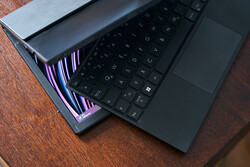
L'Asus Zenbook 17 Fold è il primo dispositivo pieghevole di grandi dimensioni disponibile sul mercato e dopo le nostre esperienze contrastanti con il vecchio Lenovo ThinkPad X1 Fold (13,3 pollici), siamo rimasti piacevolmente sorpresi dallo Zenbook nel suo complesso. Il sistema è molto versatile e la possibilità di piegare un laptop abbastanza compatto in uno schermo OLED da 17 pollici, quando lo spazio a disposizione è sufficiente, è molto allettante. Allo stesso modo, il dispositivo può essere adatto a spazi di lavoro ristretti a casa, dove è possibile collegare periferiche esterne.
Siamo rimasti piacevolmente sorpresi anche dalle prestazioni, dal momento che Asus utilizza un TDP che supera notevolmente il minimo di 9 watt fissato da Intel per il Core i7 ULV. Anche se gli utenti non devono aspettarsi miracoli e la maggior parte dei giochi sarà probabilmente ancora troppo impegnativa, il livello di prestazioni è facilmente sufficiente per le attività quotidiane come la navigazione sul web, l'editing di testo o le videoconferenze e il rumore del sistema è abbastanza silenzioso. Gli altoparlanti sono decenti e sono presenti funzioni moderne come Thunderbolt 4 e Wi-Fi 6E, mentre manca il 5G/LTE.
Soggettivamente, l'ampio schermo OLED offre un'esperienza visiva eccellente, anche se l'accuratezza dei colori non è particolarmente elevata nemmeno dopo il nostro tentativo di calibrazione. Pertanto, il pannello non è adatto a lavori di editing seri. Il lato positivo è che esiste una soluzione software per contrastare lo sfarfallio PWM.
Con lo Zenbook 17 Fold, Asus dimostra che un dispositivo pieghevole di grande formato è una possibilità reale. La possibilità di portare con sé un computer portatile abbastanza compatto, pur potendo godere dei vantaggi di un ampio schermo da 17 pollici, è entusiasmante. Tuttavia, ci sono alcuni svantaggi in alcune aree e il nuovo prodotto ha un prezzo elevato.
Naturalmente ci sono anche degli svantaggi, tra cui il prezzo di listino di 3.499 dollari. Il fatto che lo Zenbook 17 Fold sia un prodotto completamente nuovo è un aspetto di cui i potenziali acquirenti dovrebbero essere consapevoli. Inoltre, il dispositivo è relativamente ingombrante, soprattutto in modalità laptop, e ci sono alternative migliori nello spazio laptop tradizionale per i viaggi, anche se senza un ampio display da 17 pollici.
Il valore reale dello Zenbook 17 Fold sarà evidente solo quando ci saranno concorrenti diretti. Con il Lenovo ThinkPad X1 Foldun modello da 16 pollici leggermente più piccolo è già all'orizzonte.
Prezzo e disponibilità
Il nuovissimo Asus Zenbook 17 Fold non è ancora ampiamente disponibile negli Stati Uniti, anche se si prevede che sarà disponibile presso la maggior parte dei principali rivenditori entro il quarto trimestre del 2022. Al momento in cui scriviamo, solo un venditore di terze parti su Newegg vende il dispositivo all'incredibile prezzo di 6.899 dollari.
Asus Zenbook 17 Fold UX9702
- 10/17/2022 v7 (old)
Andreas Osthoff




